Working with Craft and Sustainability in a Female-Dominated Field
by: KRAFT: A Sustainable Handicraft Business , December 13, 2021
by: KRAFT: A Sustainable Handicraft Business , December 13, 2021
In Sweden, we use the word slöjd (‘sloyd’ in English)—which means ‘handicrafts’—to describe our field [1], but the word also has a more historical and cultural meaning, not to mention a heritage. In Old Nordic, the language from which the word derives, it means ‘cunning,’ ‘industriousness,’ ‘competence,’ and ‘wisdom.’ To be a person who performs sloyd in the old Norse way is to be a craftsman and artist who is skilled, nimble, inventive, well-versed, ingenious, and masterful. (SAOB 2021)
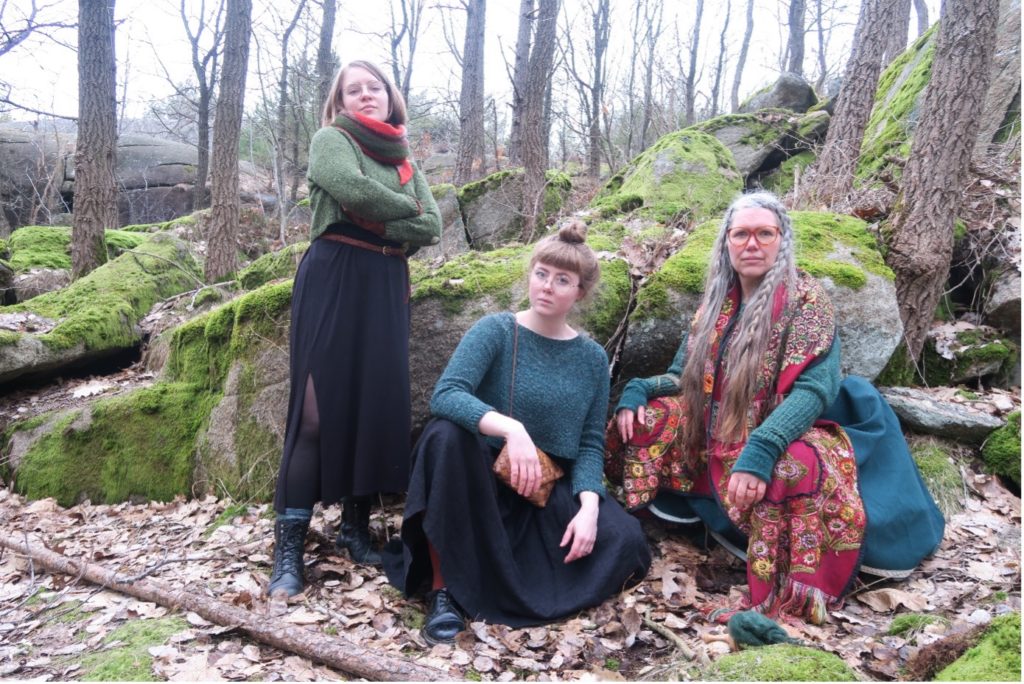
KRAFT is made up of three women—Maya Månhav, Anna Sjösvärd, and Susanne Sadri—who met at the University of Gothenburg while studying a BA course in craft as an intangible cultural heritage. Because we had previously worked in creative fields of work with high levels of competition—and in harsh environments—when we started our studies together, we were completely taken by the warm and welcoming environment that surrounded us during our three years at university. Throughout our time at GU, we were able to work closely with professionals within our field and found that we—and our work—were always taken seriously. This was quite shocking to us.
During our time together at university we helped each other to achieve our goals, and to succeed with our studies. The course we studied was small in scale—there were six of us when we started, and only the three of us finished the course—and as a result, the program was often overlooked by the department, which meant we each had to put in a great deal of extra work to make sure we got the education we signed up for.
KRAFT was founded in 2020, at the close of our three-year degree program. This coincided, of course, with the beginning of the Covid-19 crisis, which meant that our way of working had to change just a few months after we got started. We initially offered lectures and workshops related to craft and sustainability, linked to the 2030 agenda for sustainable development [2], but the onset of the pandemic meant that we had to alter our plans. Instead of in-person lectures and workshops, we moved online. More crucially, though, we launched KRAFT slöjdpåsar (‘KRAFT craft kits’) in Autumn 2020. These kits are aimed at kids and make it possible for libraries and other culture centers who purchase them to offer kids creative workshops for free, even during the pandemic when face-to-face workshops are off the table. The kits are paper bags filled with the material needed to make a certain type of craft, and we provide a video tutorial for each type of kit on our YouTube channel [3], as well as PDF tutorials for the customer to print out on demand.
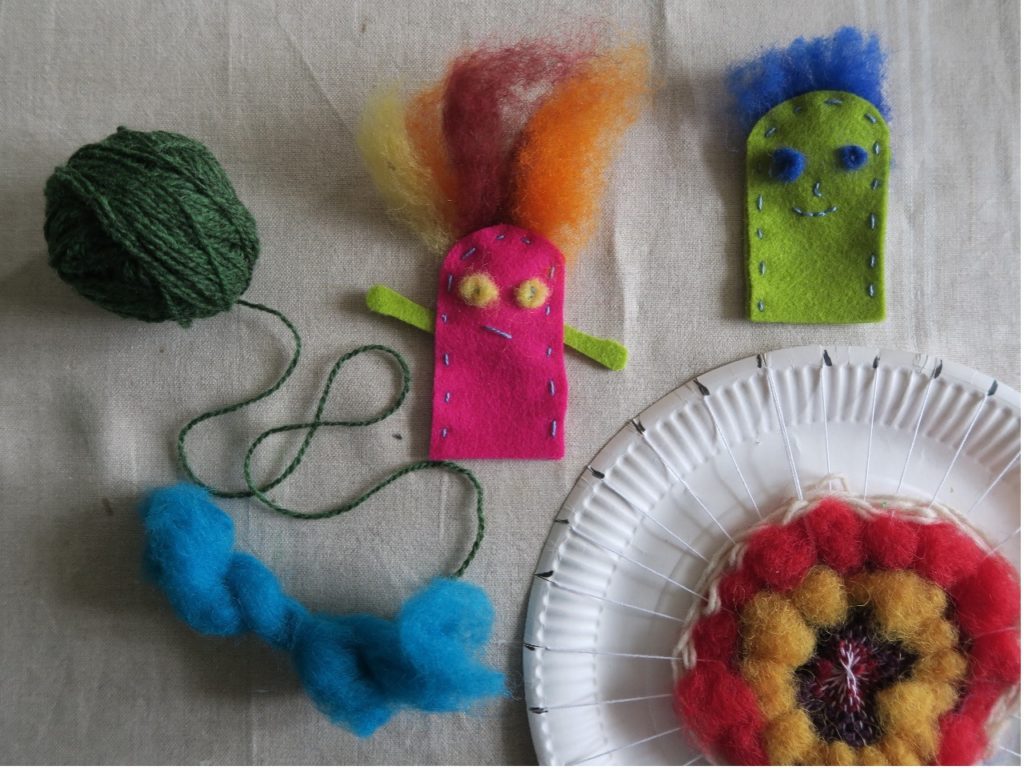
The kits are made available to order before every school holiday, so that they can be offered both instead of, and as a compliment to, the workshops that libraries and culture centres usually put on for kids. We offer a selection of four different kinds of bag each season. The minimum order is 50 craft kits of the same kind, with a discount if the customer buys 100 units, and free postage on orders of 100 or more. The bags are plastic-free, and we source as much material as we can second-hand. We try to offer different type of craft and give kids a wide variety of techniques to try, but we are limited by what is financially viable for us to put into a kit. It is also worth keeping in mind that we can’t expect kids to have specialist tools at home, which limits possibilities, and unfortunately means that we can’t offer much in the way of woodcraft. Some examples of the techniques used in our kits include wool felting, origami, bookbinding, and embroidery. Our kits include both the material and tools the kids need to make the craftwork. For example, our bookbinding kit includes the material needed to bind a simple book, including paper for the pages and coloured card for the cover, thread for sewing it together, and various items that can be used for decoration. Importantly, the kit also includes a sewing needle, because we can’t expect everybody to have access to one at home. We are constantly updating, re-thinking, and extending our catalogue of craft kits.
The craft kits started life as an attempt to make a little bit of extra money while we set up our business and waited for the pandemic to pass, but quickly became our main source of income. They continue to earn us money—though we do still offer lectures and workshops, as well as taking on project-based work.
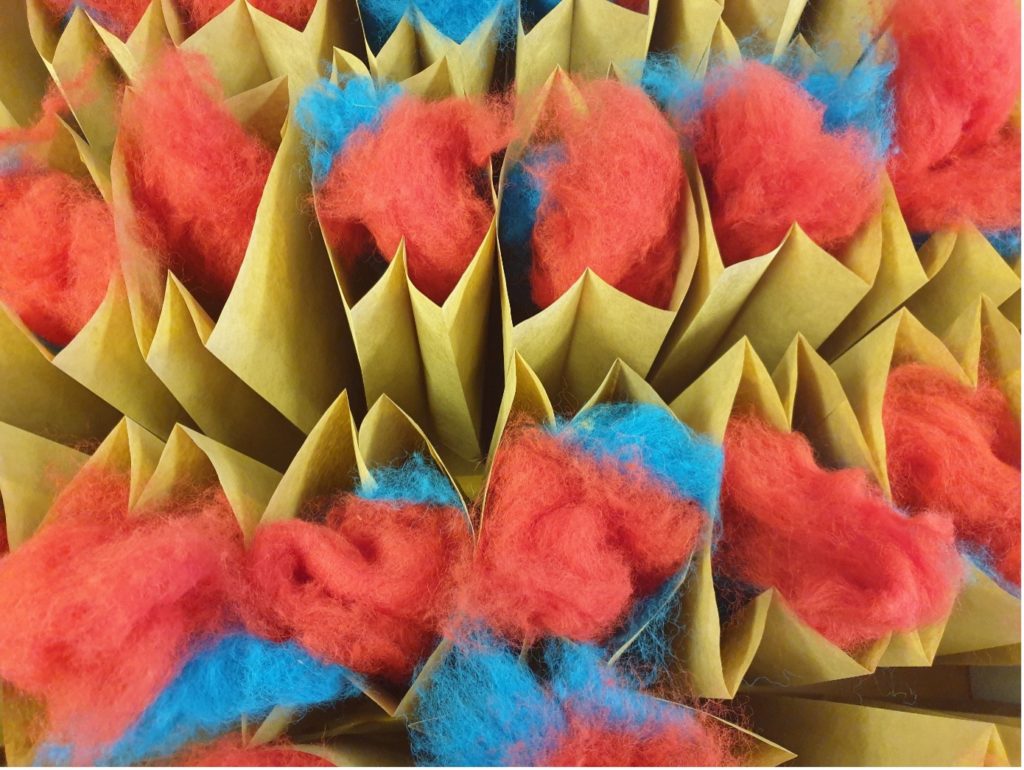
The freelance, project-based work that we have been able to undertake during this time has also proven very educational for us. Our first project-based work was a study of how we could set up an online platform to help small businesses within cultural and creative work. We worked on this project for 8 months (alongside our other work), and during this time we had the privilege of working with an amazing group of women—and we have become accustomed now to the warm, welcoming atmosphere generated by the women in our field. We have also taken part in a number of other craft-related ventures involving young people, such as a project where we guided a small group of creative young adults to launch craft kits for Fårfesten, Sweden’s biggest festival of sheep, which had to go digital in 2021. This group has now launched their own craft kits, which they sell at a museum and craft centre close to where they live, and where they first met each other. At the moment we are working on a project to integrate craft, film, and other culture at the mobile library in Torsby, Sweden.
Running Your Own Business
Running your own small business is often a gamble: it requires hard work, and it often takes time for it to provide a liveable wage. But the pros include being able to work with something you are passionate about, and the luxury of choosing both who you work with and the hours you want to work.
Early in our education, we discovered that we worked very well together. We complement each other in many ways and have craft and the urge to live sustainably as common ground. Working together has made us much stronger and far more successful as a collective than we would have been if we worked apart. We have learnt that working together in a company with no hierarchy is the easiest way to run a small business within craft. There are still tasks that all three of us would like to avoid—we take turns at these—but, for the most part we each are able to work with tasks that we are passionate about.
It can be quite stressful to run one’s own business, especially when taking part in project-based work that is time-sensitive. You must constantly find new projects to work with, and make sure to have a financial buffer to help sustain you during fallow periods, because these are unavoidable. During those times it is easy to be tempted just to give up get a 9-5 job instead, so it is extremely helpful to have co-workers and a good network of other freelancers who can lift you up, inspire you, and remind you that a difficult period is really just a phase.

We value being professional—towards other business partners, collaborators, and of course towards ourselves. We have weekly meetings (in which we stick to a strict agenda), we had our annual conference in September, and we make sure to take time off. It is important to us to make sure to have an open conversation about conflicts, contracts, and things that are less pleasant to talk about. These things are very important if you plan to work together for a long time, especially if the idea is to work with no hierarchy, and with no boss. As a collective, we are all three responsible not only for our company, but also our own and each other’s well-being.
Craft & Sustainability: A Female Trade?
Although both women and men have worked to contribute to the household, home and home tasks have tended to have been gendered female, whereas outside work and the workplace have been gendered male. (Simonton 1998: 261) Home tasks have historically included the making of all the textile products that the family would need throughout the year. This meant that the women of the family needed to know how to comb wool, spin it to a yarn, and then either knit, nalbind or weave fabric from it. This knowledge has been passed down from generation to generation, and is still with us, to some extent. (Svenson & Waldén 2005: 12-13) This is what is called an intangible heritage. It is what is passed down through hands, by watching our mothers and grandmothers make things.
Although we work with all traditional materials, textile is central to our practice. Textile craft is associated with women, and has been variously discarded, seen as a weakness in feminist circles, and used as a tool for feminism. (Svensson & Waldén 2005: 10) We see it as vital to work with textile craft, to help it gain the same status as (to name but one example) wood craft enjoys as a tool for changing gendered power structures. In our lectures and workshops, we talk about craftivism as a simple tool to use craft to convey a political statement. In craftivism you can use your craft as a tool to better engage with issues you care about. The word is a portmanteau of ‘craft’ and ‘activism,’ the intention being that one can embroider-or attach in other ways—words to a piece of fabric, and then put them up in one’s neighbourhood in order to inform and affect people in a gentler way (Corbett, 2017, p. 1-3). We in KRAFT try to give craft the recognition it needs in a world where we have almost lost the power of hand-to-brain communication. Working with one’s hands has been proven to be an important factor in brain development: performing automated tasks with our hands—most handicrafts, for example—allows sections of the brain to rest, opening us up for more creativity and free thinking (Lerners 2017). What is more, to work with craft as the crux of a business means that we are able to work closely with co-workers and customers who tend mostly to be women!
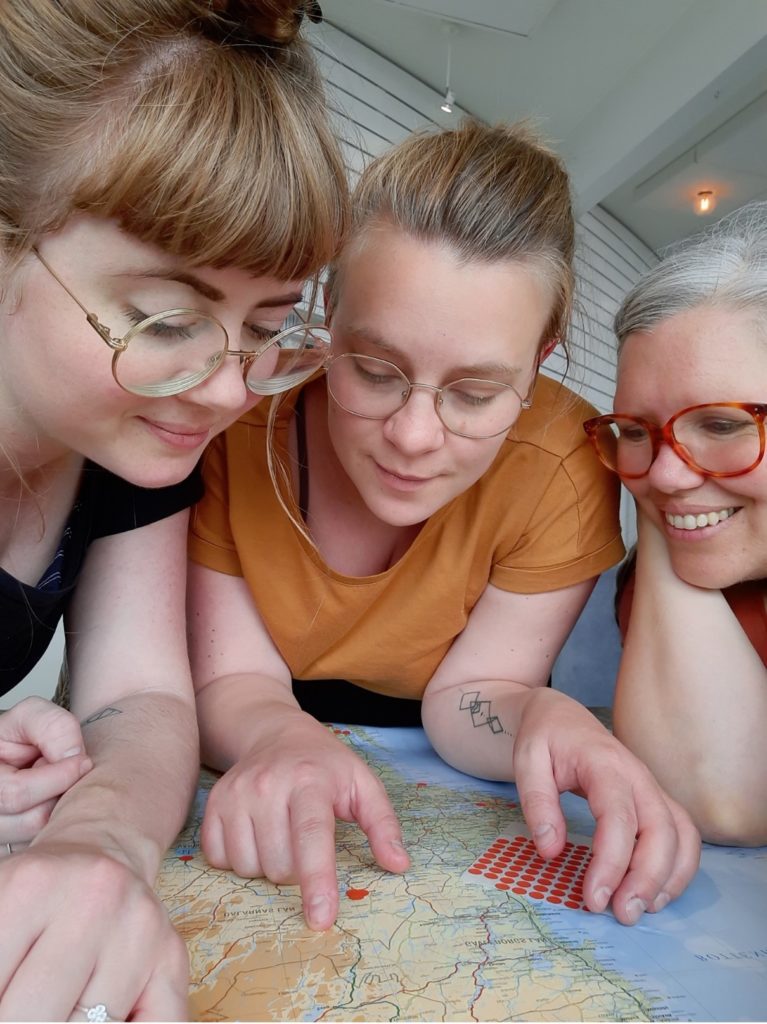
We work with craft in relation to sustainability—to work with sustainability alone was never a consideration. For us, sustainability is a part of craft, and cannot be separated from it.
But this does not preclude us keeping it in focus and endeavouring to make our work more sustainable. After all, scientific research suggests that women prioritise sustainability, and are more ready to adapt towards a more sustainable society, than men. (Swedish Environmental Protection Agency 2021)
Our experience in the field of craft and sustainability tells us that this field mainly consists of women. We work with, and meet, women in all aspects of our entrepreneurship, even though we have never actively chosen to work exclusively with women. It is, of course, possible that we trust that women will understand our work better than men and are therefore drawn to them (and vice-versa). Certainly, to work with women feels safer and less competitive for us.
Our Worth & What We are Paid
To put a price on our work is difficult. The feeling of getting to work with something that you love makes it hard to put a price on your products and services. There is also a lack of understanding of the time, skill, and effort behind the work of handicraft. Because craft isn’t highly valued, it is easy to think that the value of our work is low. To help us with this, we use the recommendations published by KRO (Konstnärernas riksorganisation, the Swedish national association for artists). These recommendations help us to set a price for our lectures, workshops, and project-based work in which we are hired to do a specific task or work as part of a project. When we worked on putting a price on our craft kits, we had to figure out a price that would be low enough to be competitive, but high enough to be worth our while. We worked this out by setting an hourly wage, counting out how many hours the different tasks would take, and then calculating the cost of the raw materials. We worked hard to set our price a little bit higher than we felt comfortable with to challenge ourselves, and to try to understand the value of our work. We recently—less than a year, in fact, after we launched the craft kits—raised our prices by about 10 %.
The process of understanding what we have the right to earn above a basic liveable income has taken a lot of work, and we have had help from different free services that are provided for small businesses here in Sweden. In this process we have also been helped by other women who comprehend the need to understand the value of our work. When we founded KRAFT, we were determined that our goal should be to have this as our main source of income. This was to be our full-time job, and would include us being able to take weekends and holidays off. This is a goal that we continue to work towards, though we know that building a business of this size takes time.
For us, working mainly with women has unequivocally been a good thing. We find that the world of handicraft creates a warm environment where we can work with what we find important, in a nurturing environment where it is more common than not to help each other. We can’t say for sure if this is due to the overrepresentation of women in this field of work, but we believe this to be a contributing factor. We have to make sure that we don’t forget that our work is important on many levels, and that we can and should achieve the financial stability that can generally be expected in more male dominated, or less sustainable, businesses.
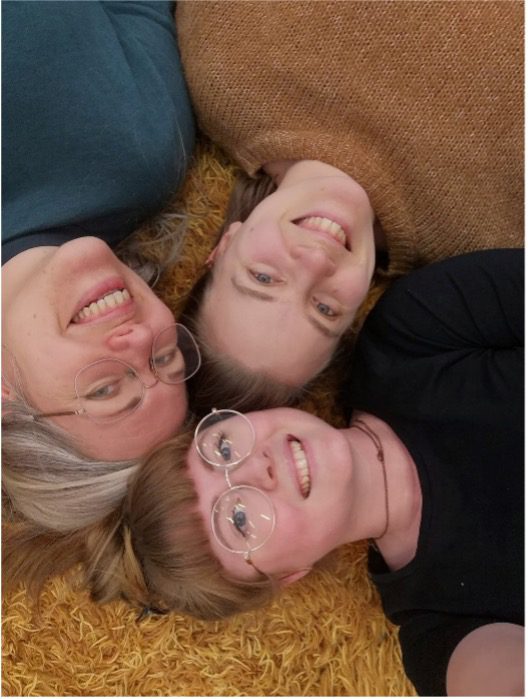
Notes
[1] Throughout this article we use the word ‘craft’ to mean ‘slöjd.’
[2] https://www.government.se/government-policy/the-global-goals-and-the-2030-Agenda-for-sustainable-development/ (last accessed 1 December 2021).
[3] https://www.youtube.com/channel/UCF637Oa7yE6fkL5iQUN U31Q (last accessed 1 December 2021).
REFERENCES
Corbett, Sarah (2017), How to be a Craftivist: The Art of Gentle Protest, London, Unbound.
KRO http://www.kro.se/uppdrag-och-ers%C3%A4ttningar/ (last accessed 1 December 2021).
Lerners Thomas (2017), ‘Så formade handen hjärnans utveckling, Modern psykologi’, https://modernpsykologi.se/2017/04/19/nu-okar-intresset-for-handens-betydelse-for-hjarnan/ (last accessed 1 December 2021).
SAOB Svenska Akademins Ordbok https://www.saob.se/artikel/?seek=sl%C3%B6jd&pz=2 (last accessed 1 December 2021).
Simonton, Deborah (1998), A History of European Women’s Work: 1700 to the Present, London: Routledge.
Svensson, Brigitta & Louise Waldén (2005), Den feminina textilen: makt och mönster, Stockholm: Nordiska Museets Förlag.
Swedish Environmental Protection Agency (2021), https://www.naturvardsverket.se/amnesomraden/klimatomstallningen/omraden/klimat-och-jamstalldhet (last accessed 1 December 2021).
KRO http://www.kro.se/uppdrag-och-ers%C3%A4ttningar/ (last accessed 1 December 2021).
Lerners Thomas (2017) Så formade handen hjärnans utveckling, Modern psykologi, https://modernpsykologi.se/2017/04/19/nu-okar-intresset-for-handens-betydelse-for-hjarnan/ (last accessed 1 December 2021).
WHO SUPPORTS US
The team of MAI supporters and contributors is always expanding. We’re honoured to have a specialist collective of editors, whose enthusiasm & talent gave birth to MAI.
However, to turn our MAI dream into reality, we also relied on assistance from high-quality experts in web design, development and photography. Here we’d like to acknowledge their hard work and commitment to the feminist cause. Our feminist ‘thank you’ goes to:
Dots+Circles – a digital agency determined to make a difference, who’ve designed and built our MAI website. Their continuous support became a digital catalyst to our idealistic project.
Guy Martin – an award-winning and widely published British photographer who’s kindly agreed to share his images with our readers
Chandler Jernigan – a talented young American photographer whose portraits hugely enriched the visuals of MAI website
Matt Gillespie – a gifted professional British photographer who with no hesitation gave us permission to use some of his work
Julia Carbonell – an emerging Spanish photographer whose sharp outlook at contemporary women grasped our feminist attention
Ana Pedreira – a self-taught Portuguese photographer whose imagery from women protests beams with feminist aura
And other photographers whose images have been reproduced here: Cezanne Ali, Les Anderson, Mike Wilson, Annie Spratt, Cristian Newman, Peter Hershey
